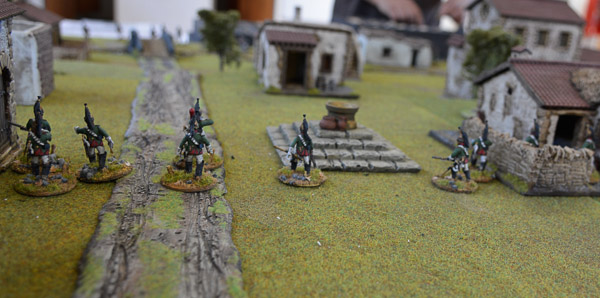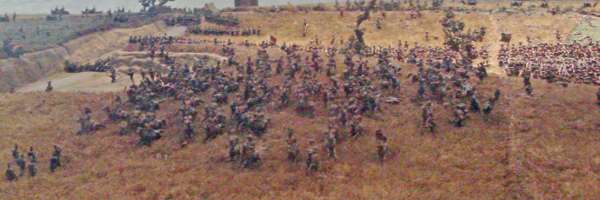In a Spanish Village somewhere between Quatre Bras and Waterloo, in Belgium, Napoleon’s advanced guard clashed with rearguard elements of Wellington’s retiring British & German allied force. My detachment of dragoons were in the vanguard of the returning Emperor’s advance, and had stopped for the evening in a strangely Spanish village not far from Quatre Bras, having pursued the English since the battle and the last mentioned place. We selected the village to billet in and establish pickets for the evening in anticipation of the arrival of the leading infantry elements of the following Corps. Unknown to us the English and their their new Allies had sent forth aggressive rear-guard patrols to the village with similar intent, and presumably hoping to deny us the village for the evening, setting the scene for a brisk late afternoon action! Continue reading “A Spanish Village near Waterloo”
Tag: Dragoons
Hundred Days British
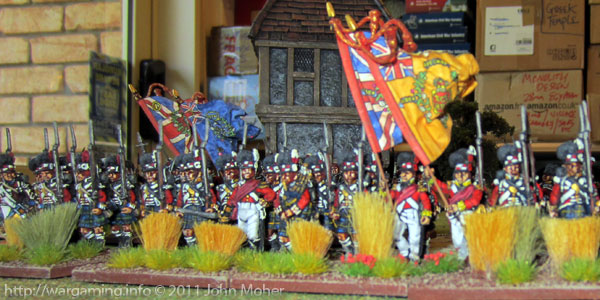
Life has been a bit hectic over Christmas – with holidays, work, catching up on gardening & clearing clutter (both wargaming and general household accumulation), and a few other matters – so I haven’t had much chance to progress any posts in January at all, even though I do have several part-written or drafted in outline. Meanwhile here’s a little eye-candy of a couple of my 28mm Napoleonic British units that featured in my ‘Hundred Days’ games in 2011!
The Siborne “Small” Model
The Siborne “Small” Model shows the area around the Brussels-Wavre crossroads including the farm of La Haye Sainte where, during the second phase of the battle of Waterloo at 1.30pm to 2.30pm (Sunday 18 June 1815), Picton’s Division engaged the Divisions of Donzelot, Alix and Marcognet, while the farm itself was still held by the Kings German Legion. This is not to be confused with Siborne’s “Large” model which depicted the entire Waterloo battlefield.
Continue reading “The Siborne “Small” Model”Lasalle: The Trouble With Tribbles
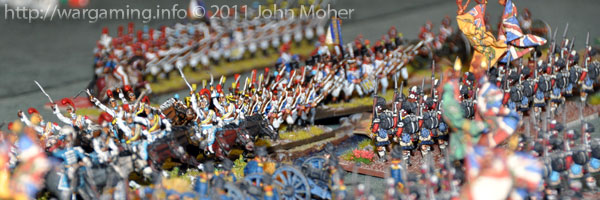
Okay – it’s got nothing to do with Star Trek & Tribbles – but I thought it sounded a cool title for a blog post (and AAR)! Anyway back at the end of July (2011) Cam and I played another Lasalle game – we reverted to the basic Army Builder List of a core force and 1 support option with standard troop values (1815 Hundred Days French & British) – the idea was to try out a proposed alternate scenario that was going to be used in the Lasalle Tournament at “Call To Arms” a convention in Wellington (New Zealand) in the second half of August. The proposed scenario in simple terms made both sides the ‘attacker’ (so Core Force + Attack Bonus + 1 Support Option) and placed 3 objectives instead of 1 on the table – all 3 having to be on the centre line, with one in the table’s dead centre, and one placed by each player not within 4BW or so of either of the others or the table edge. The following is a brief summary of the game with photo gallery…
The Crossroads
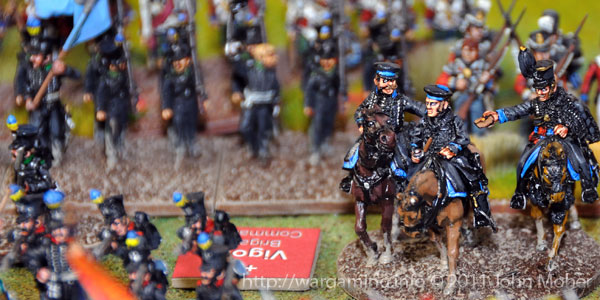
- Frederick William, Herzog von Braunschweig-Wolfenbüttel-Oels (Duke of Brunswick), leads his forces in the action at ‘The Crossroads’.
Today we played a Lasalle ‘Big Battle’ with over a Division of troops a side and had a very successful game – our first true large game with Lasalle. The scenario was based on “The Crossroads” from C. S. Grant’s “Programmed Wargames Scenarios” (Wargames Research Group Publications 1983 – Pages 79-81) modified to suit Lasalle (most especially the game turn limit and our forces). Both Cam and I did the mad panic thing during the preceding week getting extra troops and such either painted and/or based for our ‘big bash’ which allowed us to field 31 Infantry Battalions (14 French & 17 Allied) supported by 4 Batteries (2 each) and 5 Cavalry Regiments (3 small Allied and 2 large French – we had more cavalry available but did not deploy them to avoid a too ‘cavalry heavy’ game.
Picton Holds On The Chaussée de Charleroi
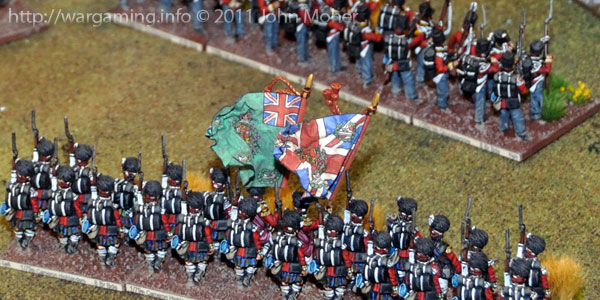
Having taken rather a beating the last two days, Picton’s division had spent the day retiring North towards Brussels and collecting stragglers, looking to join up with the balance of the Anglo-Dutch-Belgian-Brunswick-Nassau forces heading South and East towards them. Picton had received instructions from Wellington to ensure he delayed the French sufficiently to allow such a concentration of forces – and to that end Picton deployed on the fourth day to again offer battle to the pursuing 6th French Division of General de Division Prince Jérôme Bonaparte.
Continue reading “Picton Holds On The Chaussée de Charleroi”
The Hundred Days Continues…
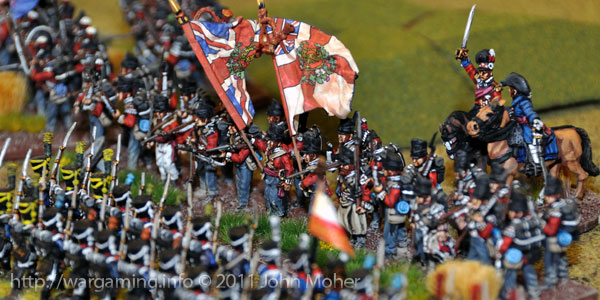
It had been a tough 2 days – having taken a heavy knock from the advanced elements of Napoleon’s invasion force (Lasalle in the Hundred Days), the elements of Picton’s Division involved had withdrawn, thankful for their temporary superiority in light cavalry, and gradually collected the stragglers and remnants of their regiments to be reconstituted as fair fighting forces again, albeit in reduced numbers… The 42nd Royal Highlanders had been detached to rejoin 9th Brigade on flank guard duty, but the latter had sent the 3/1st Royal Scots in their place – Picton was glad for the fresh, as yet uncommitted battalion. The Duke had sent word of his intent to now try and rally the Anglo-Dutch forces at a position to Picton’s rear, but that Picton must hold his position for a day to allow them time to assemble – so Picton found himself staring at what must be the most desolate part of the Southern Netherlands (i.e. Belgium), scanning the horizon for sign of the French…
Lasalle in the Hundred Days
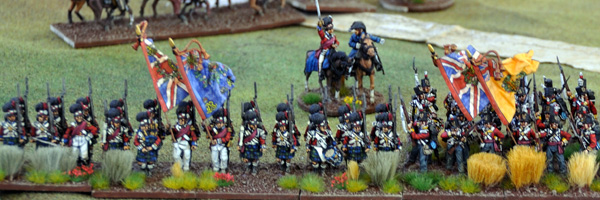
Somewhere near the Franco-Belgian border, Lieutenant-General Sir Thomas Picton surveyed the ground before him, by a strange quirk elements of his ‘reserve’ division, the 5th, had ended up near the border just as the first reports of Napoleon’s crossing reached the Allied forces. Wellesley would need time to concentrate his forces, so his Division would need to delay the initial advance elements as long as possible – and it wasn’t long before news of their arrival was received. Choosing a place with some hope of defence and a good line of withdrawal Picton deployed his troops, Major-General Sir James Kempt’s 8th Brigade on the left and centre, and elements of Pack’s 9th Brigade on the right, supported by Rogers’ Foot Company of 9pdrs on the high ground. Major-General Sir Dennis Pack meanwhile had hastened to the rear to collect and organise reinforcements and lead them forward to the battle…
Return to the English Civil War
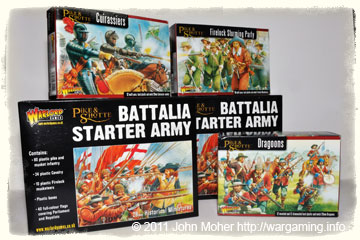
There has been a fair bit of recent discussion on the Auckland Wargaming Club group about doing a Basic Baroque 15mm ECW (English Civil War) tournament or mini-campaign. Basic Baroque is a variant to Basic Impetus & Impetus. Now I’m not much taken by 15mm armies (I’ve sworn off these completely), however the Basic Baroque rules interest me as a possible simple set for doing some 28mm ECW in the short term – especially as I long since lost interest in DBR (De Bellis Renationis) as lacking flavour for the later renaissance period and most especially the mid to late Seventeenth Century ECW & TYW (Thirty Years War) and after.
